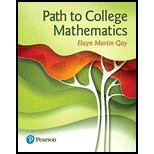
Path To College Mathematics
1st Edition
ISBN: 9780134654409
Author: Martin-Gay, K. Elayn, 1955-
Publisher: Pearson,
expand_more
expand_more
format_list_bulleted
Concept explainers
Question
Chapter B, Problem 19ES
To determine
Find the next number of the sequence using inductive reasoning.
Expert Solution & Answer
Want to see the full answer?
Check out a sample textbook solution
Students have asked these similar questions
can you explain why my answer to Q2 was wrong and, how to get the correct answer
Problem 9: The 30-kg pipe is supported at A by a system
of five cords. Determine the force in each cord for
equilibrium.
B
60º
A
E
H
Solve questions by Course Name (Ordinary Differential Equations II 2)
Chapter B Solutions
Path To College Mathematics
Ch. B - Determine whether each is an example of inductive...Ch. B - Prob. 2ESCh. B - Prob. 3ESCh. B - Prob. 4ESCh. B - Prob. 5ESCh. B - Prob. 6ESCh. B - Prob. 7ESCh. B - Prob. 8ESCh. B - Prob. 9ESCh. B - Prob. 10ES
Ch. B - Prob. 11ESCh. B - Prob. 12ESCh. B - Prob. 13ESCh. B - Prob. 14ESCh. B - Prob. 15ESCh. B - Prob. 16ESCh. B - Prob. 17ESCh. B - Prob. 18ESCh. B - Prob. 19ESCh. B - Prob. 20ESCh. B - Prob. 21ESCh. B - Prob. 22ESCh. B - Prob. 23ESCh. B - Prob. 24ESCh. B - Prob. 25ESCh. B - Prob. 26ESCh. B - Prob. 27ESCh. B - Prob. 28ESCh. B - Prob. 29ESCh. B - Prob. 30ESCh. B - Prob. 31ESCh. B - Prob. 32ESCh. B - Prob. 33ESCh. B - Prob. 34ESCh. B - Prob. 35ESCh. B - Give an example occurring outside the classroom...Ch. B - Prob. 37ESCh. B - Prob. 38ESCh. B - Prob. 39ESCh. B - Prob. 40ESCh. B - Prob. 41ESCh. B - Prob. 42ESCh. B - Prob. 43ESCh. B - Prob. 44ESCh. B - Prob. 45ESCh. B - Prob. 46ESCh. B - Prob. 47ESCh. B - Use diagrams and deductive reasoning to solve each...Ch. B - Prob. 49ESCh. B - Prob. 50ESCh. B - Prob. 51ESCh. B - Prob. 52ESCh. B - Prob. 53ESCh. B - Prob. 54ES
Knowledge Booster
Learn more about
Need a deep-dive on the concept behind this application? Look no further. Learn more about this topic, subject and related others by exploring similar questions and additional content below.Similar questions
- d((x, y), (z, w)) = |xz|+|yw|, show that whether d is a metric on R² or not?. Q3/Let R be a set of real number and d: R² x R² → R such that -> d((x, y), (z, w)) = max{\x - zl, ly - w} show that whether d is a metric on R² or not?. Q4/Let X be a nonempty set and d₁, d₂: XXR are metrics on X let d3,d4, d5: XX → R such that d3(x, y) = 4d2(x, y) d4(x, y) = 3d₁(x, y) +2d2(x, y) d5(x,y) = 2d₁ (x,y))/ 1+ 2d₂(x, y). Show that whether d3, d4 and d5 are metric on X or not?arrow_forwardplease Solve questions by Course Name( Ordinary Differential Equations II 2)arrow_forwardBusiness discussarrow_forward
- please do Q3arrow_forwardUse the properties of logarithms, given that In(2) = 0.6931 and In(3) = 1.0986, to approximate the logarithm. Use a calculator to confirm your approximations. (Round your answers to four decimal places.) (a) In(0.75) (b) In(24) (c) In(18) 1 (d) In ≈ 2 72arrow_forwardFind the indefinite integral. (Remember the constant of integration.) √tan(8x) tan(8x) sec²(8x) dxarrow_forward
- Find the indefinite integral by making a change of variables. (Remember the constant of integration.) √(x+4) 4)√6-x dxarrow_forwardInThe Northern Lights are bright flashes of colored light between 50 and 200 miles above Earth. Suppose a flash occurs 150 miles above Earth. What is the measure of arc BD, the portion of Earth from which the flash is visible? (Earth’s radius is approximately 4000 miles.)arrow_forwardJu at © Ju 370 = x (- пье zxp = c² (2² 4 ) dx² ахе 2 nze dyz t nzp Q/what type of partial differential equation (PDE) are the following-arrow_forward
arrow_back_ios
SEE MORE QUESTIONS
arrow_forward_ios
Recommended textbooks for you
 Holt Mcdougal Larson Pre-algebra: Student Edition...AlgebraISBN:9780547587776Author:HOLT MCDOUGALPublisher:HOLT MCDOUGAL
Holt Mcdougal Larson Pre-algebra: Student Edition...AlgebraISBN:9780547587776Author:HOLT MCDOUGALPublisher:HOLT MCDOUGAL College Algebra (MindTap Course List)AlgebraISBN:9781305652231Author:R. David Gustafson, Jeff HughesPublisher:Cengage Learning
College Algebra (MindTap Course List)AlgebraISBN:9781305652231Author:R. David Gustafson, Jeff HughesPublisher:Cengage Learning
 Algebra: Structure And Method, Book 1AlgebraISBN:9780395977224Author:Richard G. Brown, Mary P. Dolciani, Robert H. Sorgenfrey, William L. ColePublisher:McDougal LittellAlgebra & Trigonometry with Analytic GeometryAlgebraISBN:9781133382119Author:SwokowskiPublisher:Cengage
Algebra: Structure And Method, Book 1AlgebraISBN:9780395977224Author:Richard G. Brown, Mary P. Dolciani, Robert H. Sorgenfrey, William L. ColePublisher:McDougal LittellAlgebra & Trigonometry with Analytic GeometryAlgebraISBN:9781133382119Author:SwokowskiPublisher:Cengage Glencoe Algebra 1, Student Edition, 9780079039897...AlgebraISBN:9780079039897Author:CarterPublisher:McGraw Hill
Glencoe Algebra 1, Student Edition, 9780079039897...AlgebraISBN:9780079039897Author:CarterPublisher:McGraw Hill

Holt Mcdougal Larson Pre-algebra: Student Edition...
Algebra
ISBN:9780547587776
Author:HOLT MCDOUGAL
Publisher:HOLT MCDOUGAL

College Algebra (MindTap Course List)
Algebra
ISBN:9781305652231
Author:R. David Gustafson, Jeff Hughes
Publisher:Cengage Learning


Algebra: Structure And Method, Book 1
Algebra
ISBN:9780395977224
Author:Richard G. Brown, Mary P. Dolciani, Robert H. Sorgenfrey, William L. Cole
Publisher:McDougal Littell

Algebra & Trigonometry with Analytic Geometry
Algebra
ISBN:9781133382119
Author:Swokowski
Publisher:Cengage

Glencoe Algebra 1, Student Edition, 9780079039897...
Algebra
ISBN:9780079039897
Author:Carter
Publisher:McGraw Hill
Sequences and Series Introduction; Author: Mario's Math Tutoring;https://www.youtube.com/watch?v=m5Yn4BdpOV0;License: Standard YouTube License, CC-BY
Introduction to sequences; Author: Dr. Trefor Bazett;https://www.youtube.com/watch?v=VG9ft4_dK24;License: Standard YouTube License, CC-BY